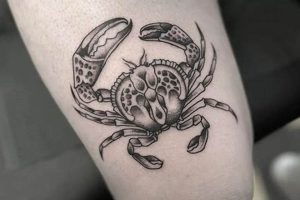Traditional Filipino tattooing, a practice with deep cultural and historical roots, offers a rich source of inspiration for contemporary body art. These designs often incorporate symbolic imagery drawn from nature, mythology, and ancestral narratives. Examples include tribal patterns, depictions of animals like the eagle or snake, and representations of deities or spirits. These designs can be rendered using traditional hand-tapped methods or modern tattoo machines, offering diverse aesthetic choices.
The resurgence of interest in these designs signifies a renewed appreciation for Filipino heritage and artistic traditions. By choosing such designs, individuals can connect with their ancestry, express cultural pride, and contribute to the preservation of a unique art form. Historically, these tattoos served as markers of status, lineage, and spiritual beliefs, reflecting the rich tapestry of pre-colonial Filipino societies. Contemporary interpretations allow individuals to personalize these ancient symbols, creating meaningful and visually striking body art.
Exploring the diverse range of available designs, considering their historical significance, and understanding the artistry behind their creation are crucial steps in selecting a meaningful and culturally relevant tattoo. Factors such as placement, size, and color palette also contribute to the overall impact and personal expression conveyed by the chosen design. Consultation with skilled and knowledgeable tattoo artists specializing in Filipino designs is essential for ensuring authenticity and achieving the desired aesthetic outcome.
1. Tribal Patterns
Tribal patterns form a cornerstone of traditional Filipino tattooing, offering a visual language deeply connected to ancestral heritage and cultural identity. These intricate designs, often passed down through generations, represent regional affiliations, lineage, and social status. Understanding the specific meanings and origins of these patterns is crucial for appreciating their significance within the broader context of Filipino tattoo art.
- Regional Variations
Different regions of the Philippines boast unique tribal tattoo patterns, reflecting the diverse cultural landscape of the archipelago. For example, the Visayan region is known for its intricate swirling designs, while the Cordillera region features bold geometric motifs. Recognizing these regional variations is essential for understanding the geographical and cultural origins of a specific design.
- Lineage and Ancestry
Historically, specific tribal patterns served as visual markers of lineage and ancestry. These designs acted as symbolic representations of familial ties and clan affiliations, allowing individuals to identify themselves within their respective communities. Choosing a tribal pattern based on ancestral heritage can create a powerful connection to one’s roots.
- Social Status and Achievements
In some traditional Filipino communities, certain tattoo patterns signified social status, achievements, or warrior prowess. These designs served as visual indicators of an individual’s accomplishments or position within the social hierarchy. Modern interpretations of these patterns can symbolize personal achievements or milestones.
- Spiritual Beliefs and Protection
Certain tribal patterns were believed to possess spiritual significance, offering protection or embodying specific beliefs. These designs often incorporated symbolic imagery representing deities, spirits, or natural forces. Selecting a pattern based on its spiritual meaning can add a layer of personal significance to the tattoo.
The enduring appeal of tribal patterns in contemporary Filipino tattooing reflects a deep respect for ancestral traditions and cultural identity. By carefully researching and selecting a design based on its regional origins, historical significance, and personal resonance, individuals can create meaningful and visually striking tattoos that honor their heritage.
2. Symbolic Imagery
Symbolic imagery plays a vital role in traditional Filipino tattoo designs, imbuing them with deeper cultural and personal meaning. These symbols, often drawn from nature, mythology, and ancestral beliefs, offer a rich visual language for expressing identity, spirituality, and connection to heritage. Understanding the symbolism embedded within these designs is crucial for appreciating their cultural significance and making informed choices for contemporary tattooing.
- Deities and Spirits
Representations of deities and spirits hold significant spiritual weight in Filipino tattooing. Figures like Bathala, the supreme god in Tagalog mythology, or various ancestral spirits, embody powerful forces and offer protection. Incorporating these figures can express reverence and connection to spiritual beliefs.
- Nature and Animals
Natural elements and animals hold symbolic meaning in Filipino culture. The eagle (agila), for instance, symbolizes strength and freedom, while the snake (ahas) represents transformation and healing. Incorporating these elements can connect the wearer to the natural world and its inherent power.
- Geometric Patterns and Shapes
Geometric patterns and shapes, while visually striking, also carry symbolic meaning. Triangles, for example, can represent strength and stability, while spirals symbolize growth and transformation. These patterns often complement other imagery, adding layers of complexity and significance to the overall design.
- Ancestral Scripts and Symbols
Ancient Filipino scripts, such as Baybayin, offer a unique way to incorporate symbolic meaning through written language. Specific characters or phrases can represent names, values, or ancestral connections. Utilizing these scripts adds a layer of historical and cultural depth to the tattoo.
The careful selection and combination of symbolic imagery within a Filipino tattoo design create a powerful and personalized expression of cultural identity and individual beliefs. Consulting with skilled tattoo artists knowledgeable in Filipino symbolism ensures accurate representation and meaningful integration of these potent symbols into contemporary tattoo art.
3. Animal Depictions
Animal depictions hold significant cultural and symbolic weight within the realm of Filipino tattoo ideas. These representations, often drawn from the rich biodiversity of the Philippine archipelago, embody specific traits, values, and spiritual beliefs. Understanding the symbolism associated with these animals provides crucial context for appreciating their inclusion in traditional and contemporary Filipino tattoo designs.
- The Eagle (Agila)
The Philippine eagle, a national symbol, represents strength, freedom, and power. Its inclusion in tattoo designs often signifies leadership, vision, and connection to ancestral heritage. The eagle’s majestic presence and cultural significance make it a powerful and evocative symbol in Filipino tattooing.
- The Snake (Ahas)
The snake, often associated with healing and transformation, symbolizes adaptability, resilience, and the cyclical nature of life and death. Its depiction in tattoos can represent overcoming challenges, personal growth, and connection to the spiritual realm.
- The Carabao (Kalabaw)
The carabao, a symbol of hard work, resilience, and prosperity, represents the agricultural heritage of the Philippines. Its inclusion in tattoo designs can symbolize diligence, perseverance, and connection to the land.
- The Shark (Pating)
The shark, revered for its strength and dominance in the marine environment, symbolizes protection, guidance, and adaptability. In tattooing, it can represent overcoming obstacles, navigating life’s challenges, and maintaining a strong connection to one’s heritage.
The selection of specific animal depictions in Filipino tattoo designs reflects a deep connection to the natural world and the cultural values associated with these creatures. By understanding the symbolism embedded within these representations, individuals can create meaningful and culturally relevant tattoos that resonate with their personal beliefs and honor their Filipino heritage.
4. Ancestral Narratives
Ancestral narratives form a cornerstone of Filipino cultural identity, providing rich source material for meaningful and historically resonant tattoo designs. These narratives, passed down through generations, encapsulate historical events, mythological beliefs, and cultural values, offering a powerful means of connecting with heritage and expressing personal identity through body art.
- Epic Poems and Legends
Epic poems like the Biag ni Lam-ang (Life of Lam-ang) and the Hinilawod offer a wealth of narrative inspiration for tattoo designs. These epics recount the heroic deeds of ancestral figures, embodying cultural values and beliefs. Visual representations of key scenes, characters, or symbolic objects from these narratives can create powerful and evocative tattoos.
- Creation Myths and Cosmologies
Filipino creation myths and cosmologies offer a rich tapestry of symbolic imagery and narrative themes. Depictions of deities, celestial beings, and the origins of the world can translate into intricate and meaningful tattoo designs. These designs can represent a deep connection to spiritual beliefs and ancestral understanding of the universe.
- Folklore and Local Legends
Local folklore and legends, often specific to particular regions or communities, provide a diverse range of narrative possibilities for tattoo art. These stories, often featuring mythical creatures, heroic figures, or cautionary tales, can be visually represented to create unique and personalized tattoos that reflect regional identity and cultural heritage.
- Historical Events and Figures
Significant historical events and figures also offer compelling narratives for tattoo designs. Representations of pre-colonial leaders, revolutionary heroes, or important historical moments can serve as powerful reminders of ancestral resilience and cultural pride. These designs can connect individuals to their historical roots and inspire a deeper understanding of their heritage.
By incorporating elements from ancestral narratives, individuals can create tattoos that transcend mere aesthetics and become powerful expressions of cultural identity, personal beliefs, and connection to their Filipino heritage. These narratives provide a rich and diverse source of inspiration, allowing for the creation of unique and meaningful tattoo designs that tell a story and honor ancestral legacies.
5. Modern Interpretations
Modern interpretations of traditional Filipino tattoo designs offer a dynamic bridge between ancestral heritage and contemporary aesthetics. This approach allows individuals to connect with their cultural roots while expressing personal style and artistic vision. By incorporating traditional motifs, symbols, and narratives into modern tattooing techniques and styles, artists and enthusiasts create fresh and evolving expressions of Filipino identity.
- Abstract and Geometric Representations
Traditional Filipino patterns and symbols can be reimagined through abstraction and geometric simplification. This approach maintains the essence of the original designs while offering a more contemporary aesthetic. For example, a tribal pattern can be deconstructed into its core geometric elements and reassembled in a minimalist and modern style.
- Fusion with Other Styles
Modern interpretations often involve fusing traditional Filipino designs with other tattooing styles, such as realism, watercolor, or dotwork. This fusion creates visually striking and unique pieces that blend cultural heritage with individual artistic preferences. For example, a realistic depiction of a Philippine eagle can be interwoven with traditional tribal patterns.
- Personalized Narratives and Symbolism
Modern interpretations allow for the personalization of traditional symbols and narratives. Individuals can incorporate elements that reflect their own stories, beliefs, and experiences, adding layers of personal meaning to the design. For instance, a traditional ancestral symbol can be combined with elements representing personal milestones or achievements.
- Placement and Composition
Modern tattooing techniques allow for greater flexibility in placement and composition. Large-scale back pieces or intricate sleeve designs can showcase complex narratives and interwoven patterns, while smaller, strategically placed tattoos can highlight individual symbols or motifs. This flexibility enables individuals to create visually impactful and personally meaningful compositions.
Modern interpretations of Filipino tattoo designs represent a vibrant and evolving art form. By respecting cultural origins while embracing contemporary aesthetics and individual expression, these interpretations contribute to the ongoing preservation and evolution of Filipino artistic traditions, ensuring their relevance and resonance for generations to come.
Tips for Choosing Philippine Tattoo Designs
Selecting a Filipino tattoo design requires careful consideration to ensure cultural sensitivity, meaningful representation, and a visually appealing outcome. These tips provide guidance for navigating the process thoughtfully and respectfully.
Tip 1: Research Thoroughly
Comprehensive research is essential. Explore various tribal patterns, symbolic imagery, and animal depictions to understand their cultural significance and regional variations. Consult reputable sources and engage with cultural experts to gain deeper insights.
Tip 2: Consult with a Specialist
Seek guidance from experienced tattoo artists specializing in Filipino tribal designs. Their expertise ensures accurate representation, culturally appropriate application, and artistic execution that honors traditional techniques.
Tip 3: Consider Placement and Size
Placement and size significantly impact the overall aesthetic and cultural meaning. Traditional placements often hold specific significance. Discuss placement options with the chosen artist to determine the most suitable location and size for the desired design.
Tip 4: Respect Cultural Significance
Recognize the cultural weight and historical context of chosen designs. Avoid trivializing or misrepresenting traditional symbols. Treat these designs with reverence and acknowledge their importance within Filipino heritage.
Tip 5: Personalize Meaningfully
While respecting tradition, incorporate personal elements that resonate with individual values and experiences. This personalization can create a deeper connection to the design while maintaining cultural integrity.
Tip 6: Prioritize Quality and Hygiene
Choose a reputable tattoo studio with high hygiene standards and experienced artists. This ensures a safe and professional experience, resulting in a high-quality tattoo that will stand the test of time.
Tip 7: Plan for Aftercare
Proper aftercare is crucial for preserving the integrity and longevity of the tattoo. Follow the artist’s instructions diligently to ensure proper healing and prevent complications.
By following these tips, individuals can embark on the journey of acquiring a Filipino tattoo with respect, understanding, and a deep appreciation for the rich cultural heritage it represents. This thoughtful approach ensures the chosen design serves as a meaningful and visually striking expression of personal identity and cultural pride.
Ultimately, a well-chosen Filipino tattoo becomes a powerful symbol of connection to ancestral heritage, artistic expression, and cultural pride. It serves as a lasting reminder of the rich history and enduring traditions that shape Filipino identity.
Frequently Asked Questions about Filipino Tattoo Designs
This section addresses common inquiries regarding Filipino tattoo designs, providing clarity on cultural sensitivity, practical considerations, and the process of acquiring meaningful body art inspired by Filipino traditions.
Question 1: What is the cultural significance of Filipino tribal tattoos?
Traditional Filipino tribal tattoos hold deep cultural significance, representing lineage, social status, spiritual beliefs, and regional affiliations. These designs often incorporate symbols and patterns specific to particular communities or ancestral groups, serving as powerful markers of identity and heritage.
Question 2: How can one ensure cultural sensitivity when choosing a Filipino tattoo design?
Thorough research and consultation with cultural experts and experienced tattoo artists specializing in Filipino designs are crucial for ensuring cultural sensitivity. Understanding the historical context, symbolism, and appropriate usage of specific designs demonstrates respect for Filipino heritage.
Question 3: What are the traditional methods and tools used in Filipino tattooing?
Traditional Filipino tattooing often involves hand-tapped methods using tools such as thorns, bone needles, and bamboo hammers. This traditional technique, known as batok, requires significant skill and precision. Modern tattoo machines are also utilized for contemporary interpretations.
Question 4: What is the average cost of a Filipino tattoo, and what factors influence pricing?
The cost of a Filipino tattoo varies depending on factors such as size, complexity, placement, the artist’s experience, and geographical location. Larger, more intricate designs typically require more time and expertise, resulting in higher costs. Consulting with multiple artists allows for comparison and informed decision-making.
Question 5: What are the essential aftercare practices for a Filipino tattoo?
Proper aftercare is essential for ensuring proper healing and preventing infection. Following the artist’s specific instructions, which may include keeping the tattoo clean, moisturized, and protected from sun exposure, promotes optimal healing and preserves the vibrancy of the design.
Question 6: How can one find reputable tattoo artists specializing in Filipino designs?
Recommendations from cultural organizations, online research, and reviewing artist portfolios can help identify reputable tattoo artists specializing in Filipino designs. Seeking artists with demonstrable experience and cultural understanding ensures authentic and respectful representation of traditional motifs.
Careful consideration of these frequently asked questions promotes informed decision-making and ensures a respectful approach to acquiring a Filipino tattoo design. This understanding contributes to the preservation and appreciation of Filipino cultural heritage through the art of tattooing.
Further exploration of specific design elements, artist portfolios, and cultural resources enhances the journey towards selecting a meaningful and visually compelling Filipino tattoo.
Philippine Tattoo Ideas
Exploration of Philippine tattoo ideas reveals a rich tapestry of cultural significance, artistic expression, and historical narrative. From intricate tribal patterns to symbolic animal depictions and ancestral narratives, these designs offer a powerful means of connecting with Filipino heritage. Modern interpretations provide a dynamic bridge between tradition and contemporary aesthetics, ensuring the continued evolution of this vibrant art form. Careful consideration of design choices, consultation with skilled artists, and respect for cultural context are essential for ensuring meaningful and authentic representations.
Philippine tattoo ideas represent more than mere body art; they embody a living connection to ancestral legacies and cultural identity. Further exploration and appreciation of these designs contribute to the ongoing preservation and celebration of Filipino artistic traditions, ensuring their continued resonance and relevance for generations to come. The enduring power of these designs lies in their ability to tell stories, honor heritage, and express individual connections to a rich and vibrant cultural legacy.







